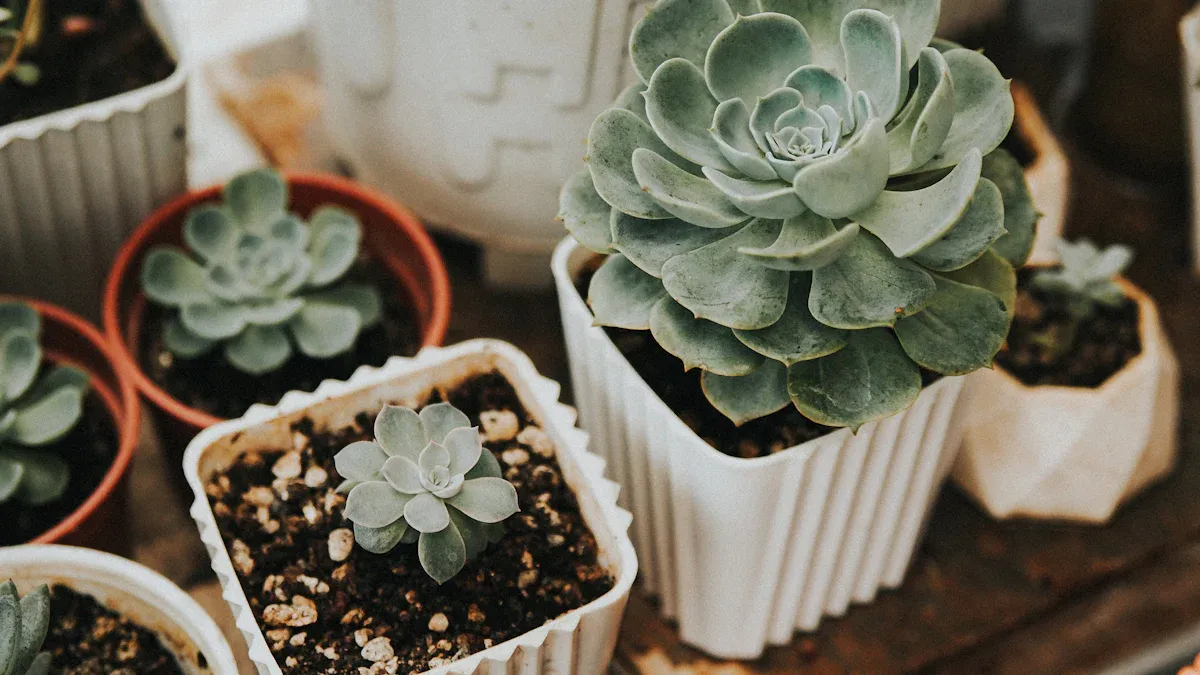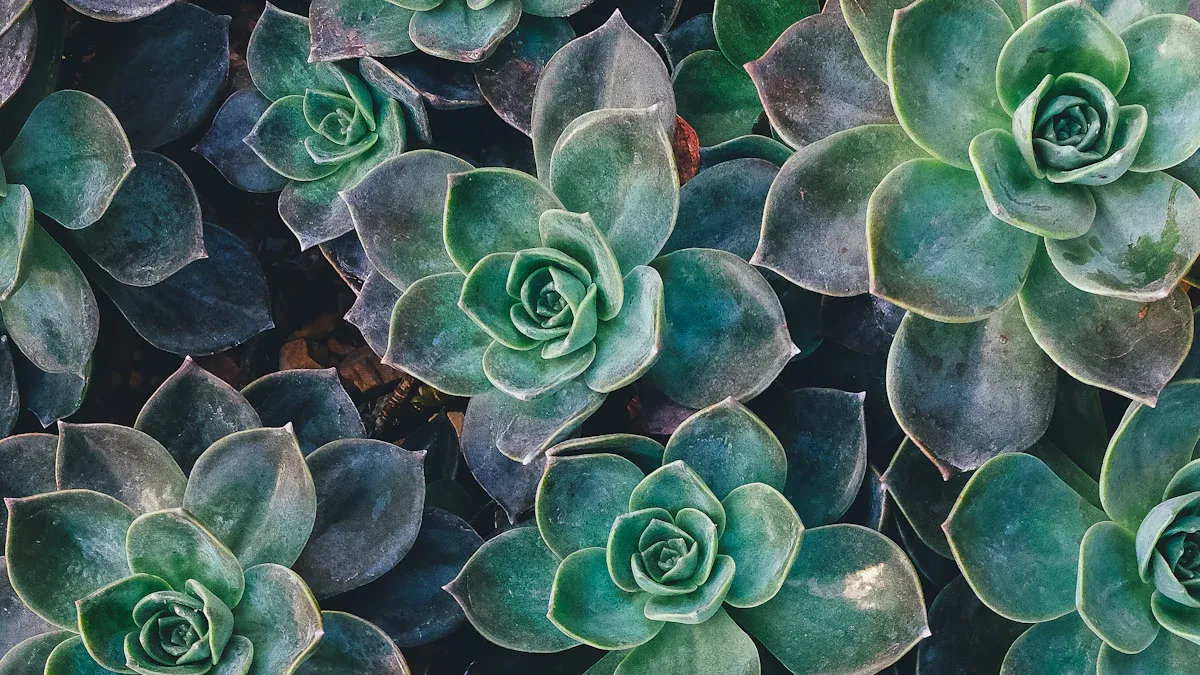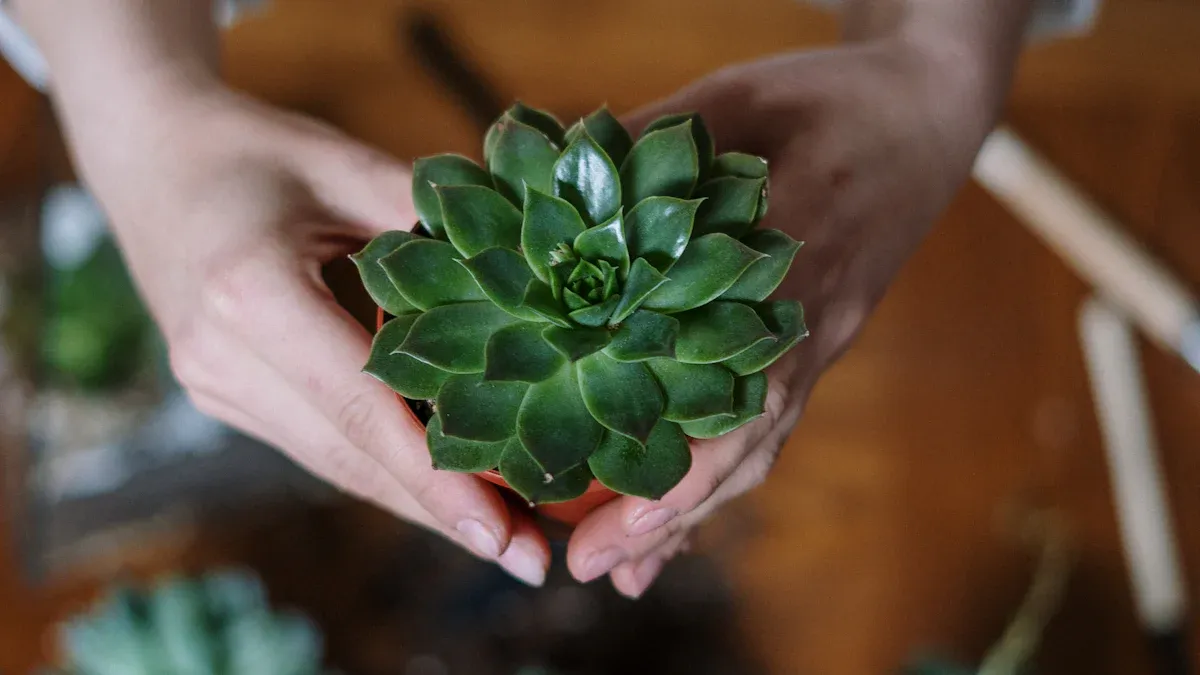
Recognizing a dying Split Rock plant can be the difference between life and death for your succulent. You might notice wilting leaves or discoloration that signals distress. Acting quickly is crucial! Don’t worry, though—by following some simple tips, you can save a dying plant and help it thrive again.
Key Takeaways
Recognize signs of distress in your Split Rock plant, such as wilting leaves, discoloration, and a soft texture. Early detection is vital for recovery.
Adjust your watering habits by using well-draining soil and only watering when the soil is completely dry. This prevents overwatering and root rot.
Ensure your plant receives enough light by placing it near a bright window or using LED grow lights. Proper light exposure boosts its health and resilience.
Symptoms of Distress

When your Split Rock plant shows signs of distress, it’s essential to recognize the symptoms quickly. Here are some key indicators that your succulent might be in trouble:
Wilting Leaves
Wilting leaves are often one of the first signs you’ll notice. If the leaves droop or appear limp, it could mean your plant is thirsty or suffering from overwatering. Look for these additional signs of overwatering:
Cracking of the epidermis
Development of more than two sets of leaves
Signs of rotting
These symptoms indicate that your plant needs immediate attention.
Discoloration
Color changes in your Split Rock plant can signal distress. You might see:
A shift to a pale or yellow hue, which often indicates too much sunlight.
A lack of vibrant stress colors, suggesting your plant is etiolated and not getting enough light.
Wrinkles in the leaves can mean thirst, but if your plant lacks wrinkles altogether, it might be facing a different issue.
These color changes are crucial to monitor, as they can help you pinpoint the problem.
Soft Texture
If your Split Rock plant feels unusually soft or mushy, it’s a clear sign of trouble. Healthy succulents should feel firm to the touch. A soft texture often indicates overwatering or root rot. If you notice this symptom, check the roots and adjust your watering habits accordingly.
By keeping an eye out for these symptoms, you can take action before it’s too late. Remember, timely intervention is key to saving your succulent!
Causes of Decline
Understanding why your Split Rock plant is struggling is crucial for its recovery. Here are the common causes of decline you should watch out for:
Overwatering
Overwatering is one of the most frequent issues for succulents, including Split Rock plants. When you give your plant too much water, it can lead to root rot. This condition is a significant concern for its health. Here’s what you need to know:
Overwatering can cause the roots to rot, making it hard for the plant to absorb nutrients.
You might notice stacking of leaves, which happens when the plant receives too much water. This indicates that you’re over-caring for it.
Split Rock plants are sensitive to excessive moisture, similar to other succulents that thrive in dry conditions.
To keep your plant healthy, remember that it’s drought-tolerant. Water only when the soil has completely dried out. During the growing season, this might mean watering every few weeks. In extreme temperatures, like summer and winter, cut back even more.
Insufficient Light
Light is essential for your Split Rock plant’s survival. If it doesn’t get enough light, it can lead to serious problems. Here’s how insufficient light affects your plant:
Low light reduces photosynthesis, which compromises plant health. This makes your plant more vulnerable to diseases.
You might see etiolation, where the plant stretches toward the light, resulting in weak growth.
Young seedlings in low light become leggy, leading to weak structures that can’t support themselves.
To ensure your Split Rock plant thrives, place it less than one foot from a window. It needs abundant, bright, and direct light to flourish.
Pests
Pests can also be a hidden threat to your Split Rock plant. These tiny invaders can cause significant damage if left unchecked. Here’s what to look for:
Common pests include mealybugs, aphids, and spider mites. They can weaken your plant by sucking out its juices.
Check the undersides of leaves and around the base of the plant for any signs of infestation.
If you notice sticky residue or webbing, it’s time to take action.
To combat pests, you can use insecticidal soap or neem oil. Regularly inspect your plant to catch any infestations early.
By understanding these causes of decline, you can take proactive steps to ensure your Split Rock plant stays healthy and vibrant. Remember, timely intervention is key!
Tips to Revive a Succulent

Reviving a succulent like your Split Rock plant can be a rewarding experience. Here are some practical tips to help you get your plant back on track.
Adjust Watering
Watering is crucial for your Split Rock plant’s recovery. Here’s how to do it right:
Use well-draining soil mixed with perlite or pumice. This enhances drainage and aeration, preventing water from sitting around the roots.
Water generously when the soil feels dry to the touch. Make sure to wait several days or even weeks before watering again. This helps prevent overwatering, which is a common mistake.
Provide water during winter. Even in colder months, your plant needs moisture to promote blooming. Just remember to keep an eye on the soil moisture level.
By adjusting your watering habits, you can help revive a succulent that’s struggling with overwatering or underwatering.
Optimize Light
Light plays a vital role in your Split Rock plant’s health. Here’s how to ensure it gets the right amount:
Place your plant near a bright window. Ideally, it should be less than one foot away from the light source. This helps your plant absorb the sunlight it needs to thrive.
Consider using LED grow lights if natural light is insufficient. Position them 6-12 inches above your plant to mimic the sunlight it craves.
Change light exposure to enhance photosynthesis. Research shows that top and side lighting can boost chlorophyll content and improve overall plant performance. This means your plant will be more resilient to stress.
Optimizing light conditions can significantly improve your plant’s chances of recovery.
Treat Pests
Pests can be a hidden threat to your Split Rock plant. Here’s how to tackle them effectively:
Inspect your plant regularly for signs of pests like mealybugs or spider mites. Look closely at the undersides of leaves and around the base.
Use neem oil as a safe treatment. It disrupts insect hormone systems, preventing pests from developing and reproducing.
Try insecticidal soap spray made from natural castile soap and water. This targets common pests without harming your plant.
Consider diatomaceous earth mixed into your potting soil. It controls pests while improving drainage and preventing mold.
By treating pests promptly, you can help revive a succulent that’s suffering from infestations.
With these tips, you can take proactive steps to save a dying plant and ensure your Split Rock thrives once again. Remember, keeping succulents healthy requires attention and care, but the rewards are worth it!
Timely intervention is crucial for your Split Rock plant’s survival. Remember to adjust watering, optimize light, and treat pests. Keep an eye out for signs of distress. By staying observant and proactive, you can help your plant become healthy and thriving once again. Your care makes all the difference!
FAQ
How often should I water my Split Rock plant?
Water your Split Rock plant every few weeks, allowing the soil to dry completely between waterings.
What type of soil is best for Split Rock plants?
Use well-draining soil mixed with perlite or pumice to promote healthy root growth and prevent rot.
Can I revive a Split Rock plant with root rot?
Yes, you can revive it! Trim away rotten roots, repot in fresh soil, and adjust your watering habits.


